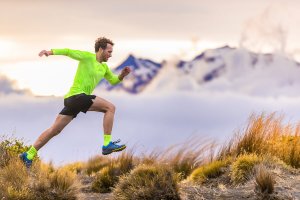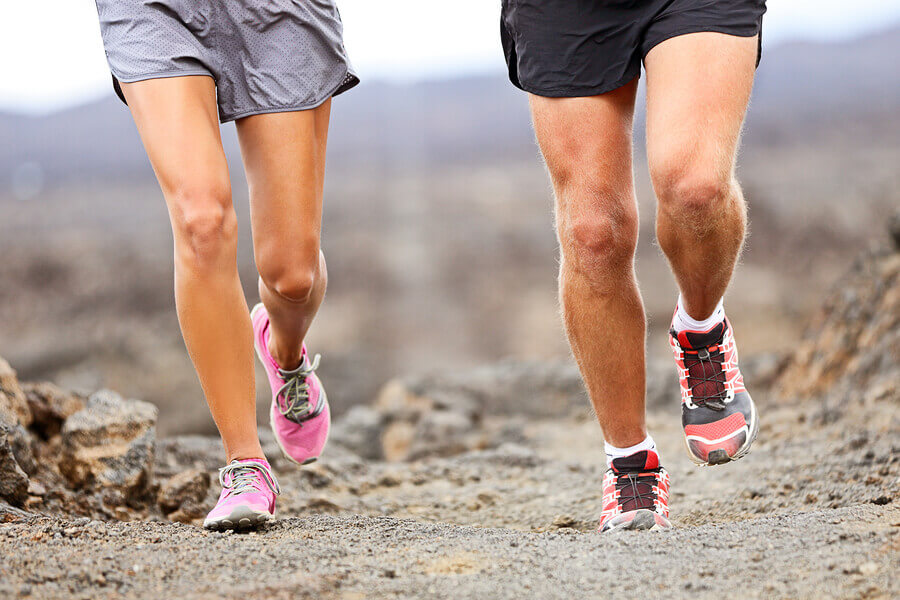6 Benefits of Trail Running you Probably Didn't Know

Running in the mountains is one of the best exercise alternatives for those who enjoy nature. In fact, more and more athletes decide to do it regularly and take advantage of its many benefits. In today’s article, we’ll go over some of the most remarkable benefits of trail running. Take note and find out more below!
Let’s start with a disclaimer. Trail running is more physically demanding than other types of running. This is especially true for people who are just starting their fitness journeys, or those accustomed to training on roads and flat surfaces.
If this is your case, it’s important that you know the more you improve your technique, the more your body can tolerate longer, faster races in the mountains.
One of the main attractions of trail running is the possibility of exploring nature trails. In most cities, there’s a wide variety of routes to choose from. This gives you the opportunity to see places and experience them in a privileged way!
Benefits of trail running
Below, we’ll list the most outstanding benefits of trail running. Take note!
1. Boost your mental health
The psychological benefits of running are well known. Trail running has the added benefit of connecting you with nature. Many people report feeling happier and more relaxed after a trail running session!
In fact, research shows that spending time outside effectively decreases stress levels, preventing cellular oxidation and boosting endorphins. You’ll feel happy, energized and ready to take on the rest of the day after a good run surrounded by nature.

2. Benefits of trail running: improve muscle strength
Running isn’t exactly considered a strength-training activity. Nevertheless, trail running engages a larger amount of muscles than running on the treadmill. The uneven terrain beneath your feet engages your core as well as your legs, and arms, to ensure you’re stable at all times.
Having a trail running schedule strengthens your core, feet, and ankles, making it easier to perform daily tasks.
3. Increase speed
Running in nature usually involves encountering some slopes. Running uphill is not only excellent for increasing resistance, but it’s also great for those looking to tone and develop leg muscles. As a consequence, you’ll improve your speed.
4. Burn more calories: benefits of trail running
There’s a pretty big difference between running on a completely flat surface on the sidewalk or in the park. The instability of the uneven trail terrain allows you to burn more calories.
Therefore, it’s advisable to start your training slowly and gradually increase the slopes in your run every week until the steepest hills no longer represent an obstacle for you. We’re sure you’ll be running up and down in no time!
5. Better weight distribution and less risk of injury
With each stride on a smooth surface, the same muscles are usually worked with an identical foot stroke, over and over again. Leaving the road and trying other types of mixed terrain surfaces causes both the pace and stride to be different. This means that you’ll distribute the impact on a wide variety of muscles, and thus reduce the risk of injury.

6. Improves your running form: benefits of trail running
When you start trail running, you’ll notice that you’re forced to take shorter steps. You’ll land more on your forefoot compared to the heel, just as it happens when you stride on the pavement.
Have no doubt that adopting this habit is really good for your running form in general. Longer strides, for example, can cause buttock injuries and other lower back problems for regular road runners.
Now that you’ve seen what the benefits of trail running are, it’s time to check them out for yourself.
Trail running can be an excellent opportunity to reconnect with nature, enjoy the good weather and challenge your body.
Of course, given it’s a very demanding exercise we recommend you start with shorter runs and gradually increase the pace. This will reduce the risk of injuries. Once you increase the length and pace of your runs week after week, you won’t believe the positive impact it has on your fitness level!
Running in the mountains is one of the best exercise alternatives for those who enjoy nature. In fact, more and more athletes decide to do it regularly and take advantage of its many benefits. In today’s article, we’ll go over some of the most remarkable benefits of trail running. Take note and find out more below!
Let’s start with a disclaimer. Trail running is more physically demanding than other types of running. This is especially true for people who are just starting their fitness journeys, or those accustomed to training on roads and flat surfaces.
If this is your case, it’s important that you know the more you improve your technique, the more your body can tolerate longer, faster races in the mountains.
One of the main attractions of trail running is the possibility of exploring nature trails. In most cities, there’s a wide variety of routes to choose from. This gives you the opportunity to see places and experience them in a privileged way!
Benefits of trail running
Below, we’ll list the most outstanding benefits of trail running. Take note!
1. Boost your mental health
The psychological benefits of running are well known. Trail running has the added benefit of connecting you with nature. Many people report feeling happier and more relaxed after a trail running session!
In fact, research shows that spending time outside effectively decreases stress levels, preventing cellular oxidation and boosting endorphins. You’ll feel happy, energized and ready to take on the rest of the day after a good run surrounded by nature.

2. Benefits of trail running: improve muscle strength
Running isn’t exactly considered a strength-training activity. Nevertheless, trail running engages a larger amount of muscles than running on the treadmill. The uneven terrain beneath your feet engages your core as well as your legs, and arms, to ensure you’re stable at all times.
Having a trail running schedule strengthens your core, feet, and ankles, making it easier to perform daily tasks.
3. Increase speed
Running in nature usually involves encountering some slopes. Running uphill is not only excellent for increasing resistance, but it’s also great for those looking to tone and develop leg muscles. As a consequence, you’ll improve your speed.
4. Burn more calories: benefits of trail running
There’s a pretty big difference between running on a completely flat surface on the sidewalk or in the park. The instability of the uneven trail terrain allows you to burn more calories.
Therefore, it’s advisable to start your training slowly and gradually increase the slopes in your run every week until the steepest hills no longer represent an obstacle for you. We’re sure you’ll be running up and down in no time!
5. Better weight distribution and less risk of injury
With each stride on a smooth surface, the same muscles are usually worked with an identical foot stroke, over and over again. Leaving the road and trying other types of mixed terrain surfaces causes both the pace and stride to be different. This means that you’ll distribute the impact on a wide variety of muscles, and thus reduce the risk of injury.

6. Improves your running form: benefits of trail running
When you start trail running, you’ll notice that you’re forced to take shorter steps. You’ll land more on your forefoot compared to the heel, just as it happens when you stride on the pavement.
Have no doubt that adopting this habit is really good for your running form in general. Longer strides, for example, can cause buttock injuries and other lower back problems for regular road runners.
Now that you’ve seen what the benefits of trail running are, it’s time to check them out for yourself.
Trail running can be an excellent opportunity to reconnect with nature, enjoy the good weather and challenge your body.
Of course, given it’s a very demanding exercise we recommend you start with shorter runs and gradually increase the pace. This will reduce the risk of injuries. Once you increase the length and pace of your runs week after week, you won’t believe the positive impact it has on your fitness level!
All cited sources were thoroughly reviewed by our team to ensure their quality, reliability, currency, and validity. The bibliography of this article was considered reliable and of academic or scientific accuracy.
- Balducci, P., Clémençon, M., Trama, R., Blache, Y., & Hautier, C. (2017). Performance Factors in a Mountain Ultramarathon. International Journal of Sports Medicine, 38(11), 819–826. https://doi.org/10.1055/s-0043-112342
- Wüthrich, T. U., Marty, J., Kerherve, H., Millet, G. Y., Verges, S., & Spengler, C. M. (2014). Aspects of respiratory muscle fatigue in a mountain ultramarathon race. Medicine and Science in Sports and Exercise, 47(3), 519–527. https://doi.org/10.1249/MSS.0000000000000449
- Morin, J. B., Tomazin, K., Edouard, P., & Millet, G. Y. (2011). Changes in running mechanics and spring-mass behavior induced by a mountain ultra-marathon race. Journal of Biomechanics, 44(6), 1104–1107. https://doi.org/10.1016/j.jbiomech.2011.01.028
- Balducci, P., Cl??men??on, M., Morel, B., Quiniou, G., Saboul, D., & Hautier, C. A. (2016). Comparison of level and graded treadmill tests to evaluate endurance mountain runners. Journal of Sports Science and Medicine, 15(2), 239–246.
-
Burtscher, J., Furtner, M., Sachse, P., & Burtscher, M. (2011). Validation of a German Version of the Sport Motivation Scale (SMS28) and Motivation Analysis in Competitive Mountain Runners. Perceptual and Motor Skills, 112(3), 807–820. https://doi.org/10.2466/05.06.25.pms.112.3.807-820
This text is provided for informational purposes only and does not replace consultation with a professional. If in doubt, consult your specialist.








